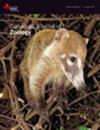Scatterhoarders use seedlings as cues of belowground food availability
IF 1
4区 生物学
Q3 ZOOLOGY
引用次数: 0
Abstract
Animals benefit from scatterhoarding, storing food around their home range for use during a period of scarcity, by later eating the stored food. Seedlings may be used as cues of belowground food. We investigated whether scatterhoarders such as eastern gray squirrels (Sciurus carolinensis Gmelin 1788) and eastern chipmunks (Tamias striatus (Linnaeus, 1758)) use characteristics of seedlings and their seeds as physical cues of the value of the seed. We buried 176 germinating seeds (white oak (Quercus alba L.), northern red oak (Q. rubra L.)) in a hardwood forest in Alabama, USA. Seeds were recovered faster with longer leaves (rate ratio [RR] = 0.68, 0.58 – 0.78, 95% confidence limits [C.L.]) and taller stems (RR = 0.91, 0.88 – 0.93, 95% C.L.) during spring 2022, and with a smaller number (RR = 1.15, 1.04 – 1.27, 95% C.L.) of longer leaves (RR = 0.81, 0.70 – 0.93, 95% C.L.) during fall 2022 (both P < 0.0001). For all seeds, we found that longer roots increased the likelihood of seeds being used (rather than ignored; OR = 1.45, 1.00 – 2.09, 95% C.L., P = 0.05). We found new evidence suggesting hoarders use above-ground cues from the seedling to dig it up and belowground seedling cues to assess seed value. These findings add to our understanding of assessing food availability for hoarding animals.散食者利用幼苗作为地下食物供应的线索
动物从分散储藏食物中获益,它们将食物储存在家园周围,以便在食物匮乏时使用,之后再吃掉储存的食物。幼苗可能被用作地下食物的线索。我们研究了东部灰松鼠(Sciurus carolinensis Gmelin 1788)和东部花栗鼠(Tamias striatus (Linnaeus, 1758))等散食者是否利用幼苗及其种子的特征作为种子价值的物理线索。我们在美国阿拉巴马州的一片阔叶林中埋藏了 176 粒发芽的种子(白栎(Quercus alba L.)、北方红栎(Q. rubra L.))。在 2022 年春季,叶片较长(比率比 [RR] = 0.68, 0.58 - 0.78, 95% 置信限 [C.L.])和茎杆较高(比率比 = 0.91, 0.88 - 0.93, 95% C.L.),而在 2022 年秋季,较长叶片的数量较少(RR = 1.15,1.04 - 1.27,95% 置信限 [C.L.])(RR = 0.81,0.70 - 0.93,95% 置信限 [C.L.])(P 均 < 0.0001)。对于所有种子,我们发现较长的根会增加种子被使用(而不是被忽略;OR = 1.45, 1.00 - 2.09, 95% C.L., P = 0.05)的可能性。我们发现了新的证据,表明囤积者利用幼苗的地上部线索来挖掘种子,并利用幼苗的地下线索来评估种子的价值。这些发现加深了我们对囤积动物评估食物可用性的理解。
本文章由计算机程序翻译,如有差异,请以英文原文为准。
求助全文
约1分钟内获得全文
求助全文
来源期刊

Canadian Journal of Zoology
生物-动物学
CiteScore
2.40
自引率
0.00%
发文量
82
审稿时长
3 months
期刊介绍:
Published since 1929, the Canadian Journal of Zoology is a monthly journal that reports on primary research contributed by respected international scientists in the broad field of zoology, including behaviour, biochemistry and physiology, developmental biology, ecology, genetics, morphology and ultrastructure, parasitology and pathology, and systematics and evolution. It also invites experts to submit review articles on topics of current interest.
文献相关原料
| 公司名称 | 产品信息 | 采购帮参考价格 |
|---|
 求助内容:
求助内容: 应助结果提醒方式:
应助结果提醒方式:


